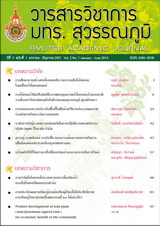การกำจัดไนโตรเจนในระบบการเพาะเลี้ยงสัตว์น้ำแบบไม่ทิ้งของเสียออกจากฟาร์ม
Main Article Content
Abstract
บทคัดย่อไม่สมบูรณ์
Nitrogen elimination in zero waste aquaculture system
As the result of an intensive development on aquaculture industry, environmental problems are therefore increased. Aquaculture systems trend to change toward the closed system such as zero waste system in which wastewater is circulated and treated inside a farm. There are many advantages, for examples: less volume of water, elimination of disease outbreak, no waste discharge into the surrounding water sources and others. Nitrogenous waste, especially dissolved ammonia-nitrogen is used by bacteria via nitrification process which produce nitratenitrogen as an end product. Many of nitrogenous waste treatment techniques have been applied such as trickling filter, rotating biological contractor, bioflocs technology and wetland. In a large farm with an area above 10 rais (16,000 m2), the wetland technique integrated with vegetable cultivation and/or trickling filtration, would be the most appropriate technique. Although bioflocs technology might be the most effective method to reduce the feed cost. On the other hand, the energy cost for operating the system is relatively high. In a small scale farm with an area less than 10 rais, the wetland technique integrated with vegetable cultivation is recommended.
Article Details
Published manuscript are the rights of their original owners and RMUTSB Academic Journal. The manuscript content belongs to the authors' idea, it is not the opinion of the journal's committee and not the responsibility of Rajamangala University of Technology Suvarnabhumi


